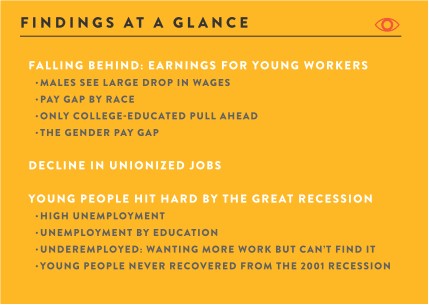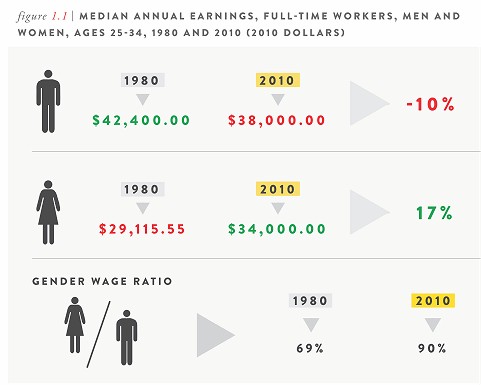
Introduction:
America’s middle class was once the envy of the world, and
the pride of our nation. But as millions still struggle with
joblessness and millions more just scrape by paycheck-
to-paycheck, the Great Recession has awakened — and
heightened — the sense that our future is in peril. Today, about half of young
Americans between the ages of 18 and 34 (called 'Millennials', i.e. people born c. 1980 and later) believe that a fundamental tenet*
of the American dream is broken — each generation will be better off than
the previous one.
Jobs and The Economy
Our nation has experienced profound economic change over
the last three decades. Globalization, new technologies, and
deliberate* public policies shifted our economy from the
production of goods to the production of knowledge and
services. As millions of unionized* factory jobs moved overseas, our nation
lost a primary source of middle-class jobs for people without college
degrees. Less-educated workers now have few options outside of non-
unionized, low-wage service occupations.

The tumultuous* economic environment has taken
a serious toll on young Americans. Paychecks have
shrunk for all but the best-educated young workers.
At the same time that the wage premium increased
for educated workers, our nation decreased its
investment in education and training — putting a
college degree out of reach of lower-income and
middle-class families. These two changes have made
it ever more difficult for young people to either work
or educate their way into the middle class.
And then the Great Recession hit, intensifying these
trends, and raising another major obstacle between
young people and economic opportunity. Unemployment and underemployment rates for young Americans
remain dangerously high — a situation that will drag down their earnings for years to come.
This generation confronts an increasingly polarized economy — characterized by declining job quality for
less-educated workers and growing inequality. In 1980, a young man with a bachelor’s degree earned roughly
$9,100 more than a young man with a high school degree. Today, he earns $20,000 more. The trends are
similar among women: in 1980, a young woman with a bachelor’s degree earned roughly $9,400 more than
a young woman with a high school degree. Today, she earns $19,000 more. (See the Data Appendix for our
detailed tables)
Without increasing educational attainment and improving job quality at the lowest rungs of the labor market
this generation will continue to struggle to match their parent’s living standards. As the wage premium on
education demonstrates and many predict, industries requiring relatively more educated workers will grow
faster than ones that do not. According to one projection, the majority of the 14 million new jobs created in
the next decade will require some type of college or training, though often an associate’s degree* will suffice*.
With falling wages and benefits in service-level jobs, the message is clear: right now, the only path to economic
opportunity for this generation runs through the doors of higher education.
Falling Behind: Earnings For Young Workers
Males See Large Drop in Wages
Young men and women experienced dramatically different earnings trends over the last generation. Overall,
young men lost ground while women’s paychecks grew steadily as more women earned college degrees, worked
longer hours, and their career opportunities increased.

• Median earnings for young
men who work full-time have
declined over the course of a
generation, falling 10 percent
between 1980 and 2010 (Figure
1.1).
• Median earnings for young
women who work full-time
increased by 17 percent over
the same period, delivering an
additional $4,880 more per
year in their paycheck in 2010
than in 1980 (Figure 1.1).
• The gender gap in pay narrowed
substantially over the last
generation. In 1980, young
women who worked full-time
earned only 69 percent of what young men earned. By 2010, young women earned almost 90 percent of
what young men earned. Young women earn less than their male counterparts at every level of education;
however, some of the narrowing of this gap is due to the much greater increase in the proportion of young
women with bachelor's degrees than men (Figure 1.1).
Pay Gap* By Race
The racial pay gap is evident among young workers with the widest gap between young Latino and white
workers.

• Median earnings for young full-time
workers are highest among Asian
Americans at $43,500, followed by whites
at $40,000 (Figure 1.2).
• The racial pay gap is evident among young
workers, with African Americans earning
only 75 cents for every dollar earned by
young whites, while Latinos earn only 68
cents for every dollar earned by young
whites (Figure 1.2).
c. 660 words (without introduction)
Source: The Databook
Annotations:
* tenet - Grundsatz, Dogma
* deliberate - beabsichtigt, wohl überlegt
* to unionize - gesellschaftlich organisieren
* tumultuous - turbulent, ungestüm
* associate degree - niedriger akademischer Grad, z.B. erworben an einem community college nach 2 jahren
* to suffice - genügen
* pay gap - Lohngefälle, Lohnkluft
Assignments:
1. How did the transformation of an economy based on production to a service industry take place?
2. What consequences did above transformation have on young people?
3. What do you think has contributed to the fact (see figure1.1) that young women's earnings have developed better than men's in the past 30 years?
4. Look at figure 1.2 and find reasons from your own knowledge why there are these differences in annual earnings?
5. Is more education for young people the only solution to better pay and more equality? Find solution approaches.
|



